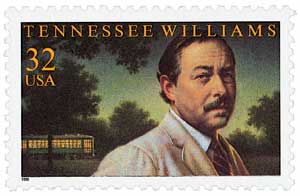
# 3002 - 1995 32c Literary Arts: Tennessee Williams
US #3002
1995 Tennessee Williams
- 14th stamp in the Literary Arts Series
- Honors Glass Menagerie playwright
Category of Stamp: Commemorative
Set: Literary Arts Series
Value: 32¢, First Class mail rate
First Day of Issue: October 13, 1995
First Day City: Clarksdale, Mississippi
Quantity Issued: 80,000,000
Printed by: Sterling Sommer for Ashton-Potter (USA) Ltd.
Printing Method: Lithographed
Format: Panes of 20 (4 across, 5 down)
Perforations: 11.1
Reason the stamp was issued: This stamp honoring playwright Tennessee Williams is the 14th in the Literary Arts series.
About the stamp design: Illustrator Michael Deas created the artwork for the Tennessee Williams stamp. He used a photo taken in 1966 as the basis for his painting. In the background, a lighted streetcar can be seen. This is in reference to Williams’ Pulitzer Prize winning play, A Streetcar named Desire.
First Day City: The First Day of Issue ceremony took place as part of the Tennessee Williams Festival held in the author’s hometown of Clarksdale, Mississippi.
About the Literary Arts Series: The Literary Arts Series began in 1979 with a John Steinbeck stamp. The objective of the Literary Arts Series is to honor America’s most renowned authors. As the USPS put it, “These skillful wordsmiths spun our favorite tales – and American history along with them.” The series honors both well-known and lesser-known authors, making it like an encapsulation of America’s rich and varied literary history.
History the stamp represents:
The second of three children, Williams was struck with diphtheria as a child and nearly died. The yearlong recuperation left him frail, which upset his father, a descendant of hardy Tennessee pioneers. Williams would later base much of his writing on his dysfunctional family and childhood.
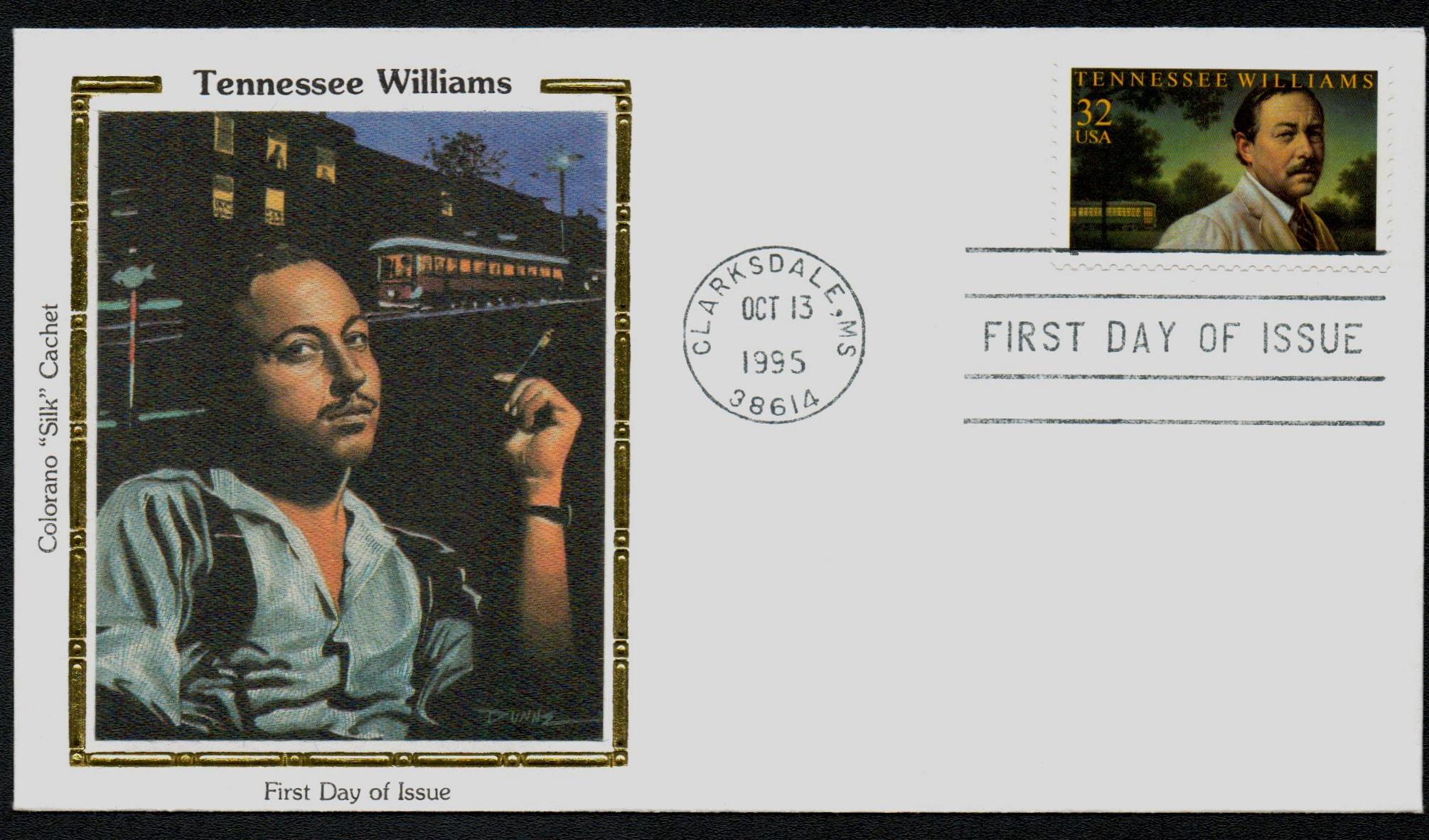
The family moved around St. Louis, Missouri, several times during Williams’ childhood. When he was 16, his essay “Can a Good Wife Be a Good Sport?” won third place in a contest. The following year, his short story “The Vengeance of Nitocris” was published in Weird Tales magazine.
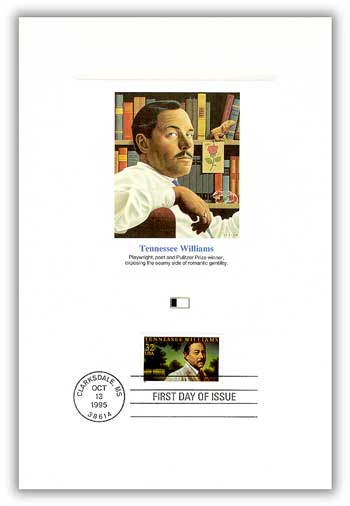
Williams attended the University of Missouri where he studied journalism. In his spare time, he wrote poetry, essays, stories, and plays for contests to make money. His play Beauty is the Word, received an honorable mention, making him the first freshman to receive that honor.
Williams’ father removed him from university after two years and made him work at a shoe factory. Williams hated the job but resolved to write even more, spending his nights and weekends producing a story a week. However, by the time he was 24, Williams was overworked and depressed and quit his job. (This period would later serve as inspiration for Stanley Kowalski in A Streetcar Named Desire.)
Williams decided to resume his education first at Washington University in St. Louis and then the University of Iowa. After graduating, Williams went on to study at the Dramatic Workshop in New York City. He adopted the name “Tennessee Williams” around 1939.
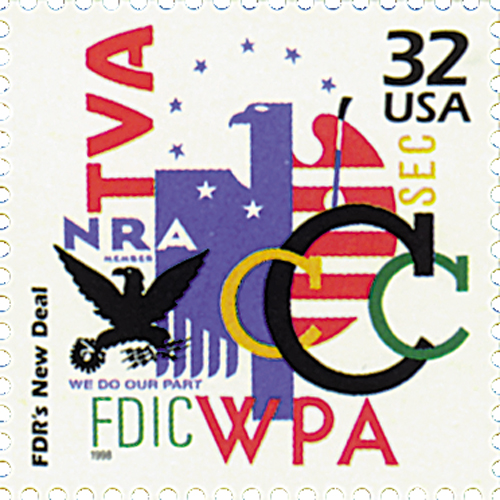
While waiting for his big break as a writer, Williams worked a series of odd jobs, including as a caretaker on a chicken ranch. His first professional production was Battle of Angels. For that work, he received a Rockefeller Foundation grant for $1,000, which he used to move to New Orleans in 1939. While there he worked as a writer for Roosevelt’s Works Progress Administration (WPA). Around this time, Hollywood took note of his Rockefeller grant and he received a six-month contract with Metro Goldwyn Mayer.
In 1944, Williams had another major break – his play The Glass Menagerie debuted in Chicago to positive reviews. When the play moved to New York it became a huge hit and made Williams famous. Combining semiautobiographical material with innovative stage techniques, this play won a New York Drama Critics’ Circle Award for best play of the season.
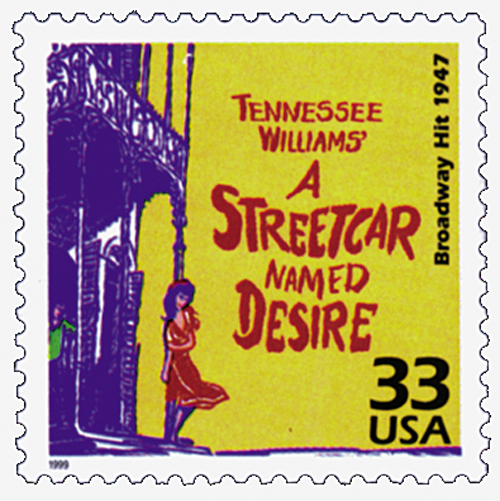
Williams had another major hit just a couple years later with the Pulitzer Prize-winning A Streetcar Named Desire. Despite his success, Williams was restless and believed he needed to move often for inspiration. As he explained it, “Only some radical change can divert the downward course of my spirit, some startling new place or people to arrest the drift, the drag.”
Over the next decade, seven more of Williams’ plays appeared on Broadway: Summer and Smoke (1948), The Rose Tattoo (1951), Camino Real (1953), Cat on a Hot Tin Roof (1955), Orpheus Descending (1957), Garden District (1958), and Sweet Bird of Youth (1959). He earned another Pulitzer, two more New York Drama Critics Circle Awards, three Donaldson Awards, and a Tony. Several of his plays were also made into movies.
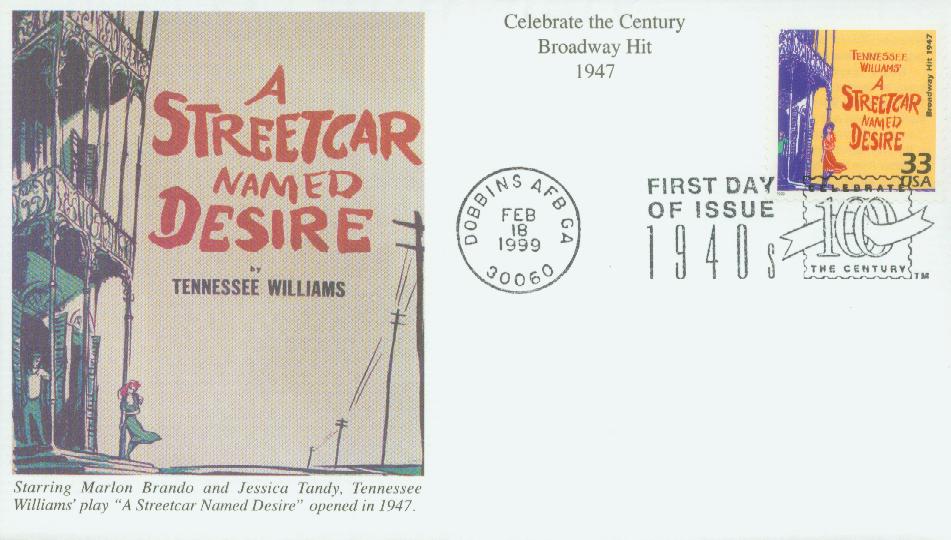
Williams’ work of the 1960s and 70s was not as well received and his popularity waned. He died on February 25, 1983, in New York City.
Click here to read some of Williams’ poetry.
US #3002
1995 Tennessee Williams
- 14th stamp in the Literary Arts Series
- Honors Glass Menagerie playwright
Category of Stamp: Commemorative
Set: Literary Arts Series
Value: 32¢, First Class mail rate
First Day of Issue: October 13, 1995
First Day City: Clarksdale, Mississippi
Quantity Issued: 80,000,000
Printed by: Sterling Sommer for Ashton-Potter (USA) Ltd.
Printing Method: Lithographed
Format: Panes of 20 (4 across, 5 down)
Perforations: 11.1
Reason the stamp was issued: This stamp honoring playwright Tennessee Williams is the 14th in the Literary Arts series.
About the stamp design: Illustrator Michael Deas created the artwork for the Tennessee Williams stamp. He used a photo taken in 1966 as the basis for his painting. In the background, a lighted streetcar can be seen. This is in reference to Williams’ Pulitzer Prize winning play, A Streetcar named Desire.
First Day City: The First Day of Issue ceremony took place as part of the Tennessee Williams Festival held in the author’s hometown of Clarksdale, Mississippi.
About the Literary Arts Series: The Literary Arts Series began in 1979 with a John Steinbeck stamp. The objective of the Literary Arts Series is to honor America’s most renowned authors. As the USPS put it, “These skillful wordsmiths spun our favorite tales – and American history along with them.” The series honors both well-known and lesser-known authors, making it like an encapsulation of America’s rich and varied literary history.
History the stamp represents:
The second of three children, Williams was struck with diphtheria as a child and nearly died. The yearlong recuperation left him frail, which upset his father, a descendant of hardy Tennessee pioneers. Williams would later base much of his writing on his dysfunctional family and childhood.

The family moved around St. Louis, Missouri, several times during Williams’ childhood. When he was 16, his essay “Can a Good Wife Be a Good Sport?” won third place in a contest. The following year, his short story “The Vengeance of Nitocris” was published in Weird Tales magazine.

Williams attended the University of Missouri where he studied journalism. In his spare time, he wrote poetry, essays, stories, and plays for contests to make money. His play Beauty is the Word, received an honorable mention, making him the first freshman to receive that honor.
Williams’ father removed him from university after two years and made him work at a shoe factory. Williams hated the job but resolved to write even more, spending his nights and weekends producing a story a week. However, by the time he was 24, Williams was overworked and depressed and quit his job. (This period would later serve as inspiration for Stanley Kowalski in A Streetcar Named Desire.)
Williams decided to resume his education first at Washington University in St. Louis and then the University of Iowa. After graduating, Williams went on to study at the Dramatic Workshop in New York City. He adopted the name “Tennessee Williams” around 1939.

While waiting for his big break as a writer, Williams worked a series of odd jobs, including as a caretaker on a chicken ranch. His first professional production was Battle of Angels. For that work, he received a Rockefeller Foundation grant for $1,000, which he used to move to New Orleans in 1939. While there he worked as a writer for Roosevelt’s Works Progress Administration (WPA). Around this time, Hollywood took note of his Rockefeller grant and he received a six-month contract with Metro Goldwyn Mayer.
In 1944, Williams had another major break – his play The Glass Menagerie debuted in Chicago to positive reviews. When the play moved to New York it became a huge hit and made Williams famous. Combining semiautobiographical material with innovative stage techniques, this play won a New York Drama Critics’ Circle Award for best play of the season.

Williams had another major hit just a couple years later with the Pulitzer Prize-winning A Streetcar Named Desire. Despite his success, Williams was restless and believed he needed to move often for inspiration. As he explained it, “Only some radical change can divert the downward course of my spirit, some startling new place or people to arrest the drift, the drag.”
Over the next decade, seven more of Williams’ plays appeared on Broadway: Summer and Smoke (1948), The Rose Tattoo (1951), Camino Real (1953), Cat on a Hot Tin Roof (1955), Orpheus Descending (1957), Garden District (1958), and Sweet Bird of Youth (1959). He earned another Pulitzer, two more New York Drama Critics Circle Awards, three Donaldson Awards, and a Tony. Several of his plays were also made into movies.

Williams’ work of the 1960s and 70s was not as well received and his popularity waned. He died on February 25, 1983, in New York City.
Click here to read some of Williams’ poetry.












